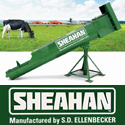 |
 |

|
|
|
New York Ag News Headlines |
 |
Boaters Encouraged to Help Prevent Invasive Species Spread
New York Ag Connection - 05/25/2018
The New York State Departments of Environmental Conservation (DEC), Transportation (DOT) and Office of Parks, Recreation, and Historic Preservation (State Parks) announced that beginning this weekend, boat stewards will be deployed at nearly 200 locations across the state as part of a collaborative program to prevent the introduction and spread of aquatic invasive species (AIS).
"The boat steward partnership program provides a vital function in protecting New York's waters and raising public awareness about aquatic invaders that could harm the health of our rivers, lakes, and streams, as well as the fish and plants that inhabit them," said DEC Commissioner Basil Seggos. "Under Governor Cuomo's leadership and continued support from the State's Environmental Protection Fund to fight invasive species, we are continuing to educate the public about the dangers of these invasive species and protect our invaluable natural resources and waters."
"Aquatic invasive species can ruin boating and fishing trips, reduce shoreline property values and undermine the tourism industry," State Parks Commissioner Rose Harvey said. "I encourage boaters to learn and practice the simple steps they can take to help prevent invasive species from spreading into New York State waters."
New York State Department of Transportation Acting Commissioner Paul A. Karas said, "Aquatic invasive species pose a serious threat, which is why the New York State Department of Transportation is working with the Adirondack Park Invasive Plant Program and our sister agencies to host boat inspection and decontamination stations. We are also continuously locating new ones along state highways, including at the new Adirondack Welcome Center being built on I-87 in Queensbury. Working together with the boating community we will help prevent the spread of these invaders and protect our precious water resources."
The New York State Department of Transportation is working with the Adirondack Park Invasive Plant Program, DEC, State Parks and local communities to host boat inspection and decontamination stations and help establish new ones along state highways, including at the Adirondack Welcome Center being built on Interstate 87 in Queensbury, Warren County. Locating regional inspection stations on primary travel corridors helps obviate the need to construct and staff stations at individual lakes and streams.
AIS are non-native aquatic plants and animals that can cause environmental and economic harm and harm to human health. Many AIS have been found in the lakes, ponds, and rivers of New York. These plants and animals are often transported from waterbody to waterbody on watercraft and equipment.
Boat stewards are volunteers or paid members of the community that provide boaters and other water recreationists with important information about precautions to reduce the likelihood of spreading AIS. The stewards help people learn how to inspect, clean, drain, and treat watercraft and equipment. Stewards also ask where boaters last launched and can sometimes determine what invasive species are found in the lake or pond visited through the iMapInvasives website at http://www.nyimapinvasives.org/.
DEC and State Parks are working with local governments, lake associations, the Adirondack Park Invasive Plant Program (APIPP) and Paul Smith's College Adirondack Watershed Institute (AWI) in taking a frontline defense against invasive species, such as Eurasian watermilfoil and spiny water flea, in waterbodies in the Adirondacks. This effort is funded by the state Environmental Protection Fund (EPF), including $9 million in funding for a five-year management contract with AWI. Funding for programs in other areas of the state is made up through a combination resources including the U.S. Fish and Wildlife Great Lakes Restoration Initiative and EPF AIS prevention grants. In addition, State Parks has entered a partnership with the State University of New York College of Environmental Science and Forestry (SUNY ESF) to place boat stewards at approximately 30 State Parks-owned boat launches across the state.
Since 2008, the number of boat steward programs has been steadily increasing. To date, more than 25 programs are active in the state through Partnerships for Regional Invasive Species Management (PRISM), including the Finger Lakes and more recently established in the Lower Hudson Valley, Long Island, the Capital District/Mohawk River area, and Western New York. Many types of organizations pursue boat steward programs, such as lake associations, colleges and universities, non-profits, county soil and water conservation districts, and municipalities. More information about individual programs can be found in the list of Active Watercraft Inspection Programs 2017 (PDF, 1.78 MB).
New York has more than 7,000 lakes, ponds, and rivers that could potentially be exposed to dozens of harmful aquatic invasive species (www.dec.ny.gov/animals/50272.html). One of the main pathways for transfer of aquatic invasive species between waterbodies is recreational water vehicles (boats, canoes, kayaks, and jet skis). Aquatic invasive plants and animals such as hydrilla, water chestnut, Eurasian watermilfoil, zebra mussels, and Asian clams are easily transported on boats, boat trailers, and recreational gear.
State regulation requires water recreationists to take reasonable precautions to prevent the spread of AIS (www.dec.ny.gov/animals/99141.html) and New York is expanding boat steward programs across the state, particularly in popular, high-use areas. In-person interactions with boaters, anglers, and other recreational water users raises awareness about aquatic invasive species and practices (cleaning, draining, and treating) that reduce the chance of spreading aquatic invaders.
DEC advises boaters and anglers to check boats, trailers, and other fishing and boating equipment for any plants or animals that may be clinging to it. Be sure to check bunks, rollers, trim tabs and other likely attachment points on boats and trailers. Following a thorough inspection, DEC encourages boaters to follow the CLEAN, DRAIN, and DRY standard:
1. CLEAN boats, trailers and equipment of any debris, and dispose of it in an upland area or receptacle provided for this purpose.
2. DRAIN the boat completely, including bilge areas, live wells and bait wells. Water ski and wake board boat operators should be sure to drain all ballast tanks. Many aquatic invasive species can survive in as little as a drop of water, so it is imperative that all water is removed.
3. DRY all equipment for at least five days before using it in another water body. Longer drying times may be required for difficult to dry equipment or during damp or cool periods. Recommended drying times for various seasons (offsite link) can be found at 100th Meridian Initiative website. Drying is the simplest and most effective way to ensure equipment does not transport plants or animals.
If boating equipment cannot be completely and thoroughly dried, it must be decontaminated prior to use in another water body. Various decontamination techniques and special techniques to clean boats previously used in zebra mussel infested waters are provided on DEC's website. For a listing of the AIS reported from publicly accessible state waters, visit the DEC boating access directory.
Many resources are available for organizations interested in learning more about what is involved in starting a boat steward program and how to improve upon and expand existing programs. DEC has compiled a variety of useful information for new and existing steward programs, including locations of active boat stewards and boat launches, funding opportunities, and training tools available at www.dec.ny.gov/animals/107807.html.
|
 |


|
 |
|
Copyright © 2024 - Farms.com. All Rights Reserved. |
 |
|